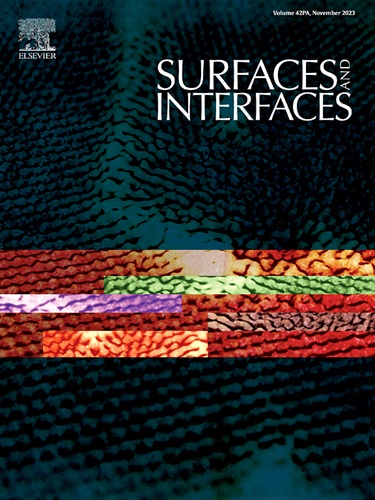ZnO纳米粒子对胺化石墨烯化学和电子性能的影响:从头算和实验探测
IF 5.7
2区 材料科学
Q2 CHEMISTRY, PHYSICAL
引用次数: 0
摘要
石墨烯/金属氧化物纳米颗粒(NPs)复合材料的新兴多功能领域促进了储能和气体传感系统的发展。然而,随着复杂设计复合材料的不断发展,对其化学和形态物理的明确理解开始消退。在这里,我们渴望暗示氧化锌纳米颗粒对胺化石墨烯的影响,将理论建模与彻底的实验检查结合起来(透射电子显微镜,x射线光电子,x射线吸收精细结构和价带光发射光谱,以及温度相关的薄片电阻测量)。首先建立了Am-ZnO复合材料的模型框架,并通过实验探测对其进行了彻底的验证,我们逐步研究了材料的性能。氧化锌表面化学对键合的影响,在理论上经常被忽视,通过核能级光谱强调。通过实验指出了ZnO NPs引起的能带结构和电荷局域化变化,并补充了所开发的电导率计算方法。鉴于这些结果,石墨烯、纳米粒子及其界面在化学阻性信号外观中的作用将进一步得到阐述。综上所述,我们的研究结果提示了金属氧化物NPs和衍生化石墨烯之间相互作用的机制,推动了这种复合材料的工程实际应用。本文章由计算机程序翻译,如有差异,请以英文原文为准。

Delving into the effect of ZnO nanoparticles on the chemistry and electronic properties of aminated graphene: Ab initio and experimental probing
The emerging versatile realm of graphene/metal oxide nanoparticles (NPs) composites has boosted the development of energy storage and gas sensing systems. However, with the advancements in deriving composites of more complex designs, the explicit understanding of their physics with respect to chemistry and morphology began to fade. Here, we aspire to hint at the effect of ZnO nanoparticles on aminated graphene, bundling theoretical modeling with thorough experimental examination (Transmission electron microscopy, X-ray photoelectron, X-ray absorption fine structure and valence-band photoemission spectroscopies, and temperature-dependent sheet resistance measurements). Starting with setting up the framework for modeling the Am-ZnO composite with its thorough verification by experimental probing, we stepwise examine the material’s properties. The effect of ZnO surface chemistry on bonding, often neglected theoretically, is highlighted by core-level spectroscopy. In turn, band structure and charge localization alterations induced by ZnO NPs are pointed out experimentally, supplemented with the developed method for conductivity calculations. Given these results, the role of graphene, NPs, and their interface in chemiresistive signal appearance is further featured. Taken together, our results give a hint at the mechanisms underlying the interaction between the metal oxide NPs and derivatized graphene, advancing the engineering of such composites for practical applications.
求助全文
通过发布文献求助,成功后即可免费获取论文全文。
去求助
来源期刊

Surfaces and Interfaces
Chemistry-General Chemistry
CiteScore
8.50
自引率
6.50%
发文量
753
审稿时长
35 days
期刊介绍:
The aim of the journal is to provide a respectful outlet for ''sound science'' papers in all research areas on surfaces and interfaces. We define sound science papers as papers that describe new and well-executed research, but that do not necessarily provide brand new insights or are merely a description of research results.
Surfaces and Interfaces publishes research papers in all fields of surface science which may not always find the right home on first submission to our Elsevier sister journals (Applied Surface, Surface and Coatings Technology, Thin Solid Films)
 求助内容:
求助内容: 应助结果提醒方式:
应助结果提醒方式:


